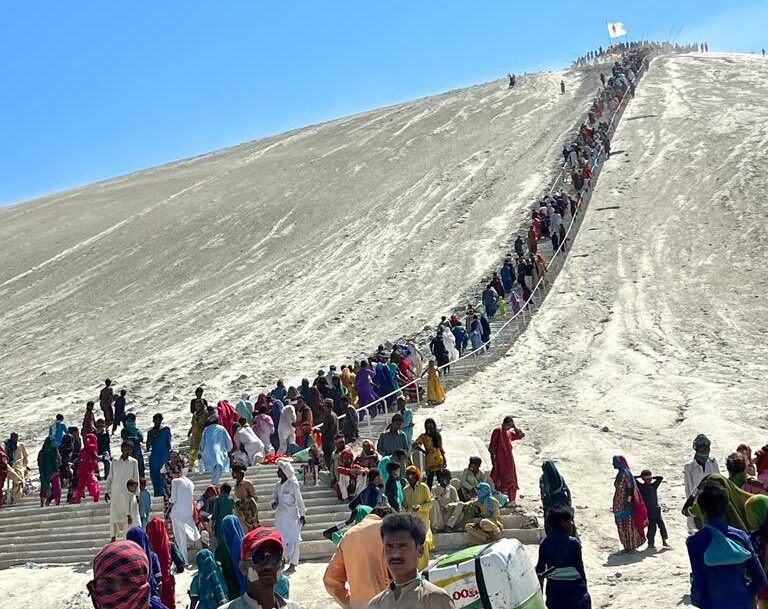
A long queue of Yatris participating in the Hinglaj Mata festival: Photo taken from the Twitter account of Chief Secretary Balochistan
by Zafar Yousafzai 17 May 2023
The three-day Hinglaj Yatra festival at Hinglaj Mata Mandir in Lasbela, Balochistan, holds immense significance for the Hindu community in Pakistan. This annual religious event serves as a major attraction for Hindus from all over the country. The success and popularity of festivals like Hinglaj Yatra demonstrate that Balochistan is much more than its stereotypes of poverty and extremism. It highlights the improving law and order situation in the province, with hundreds and thousands of people joining the festivities from across the globe.
The grand scale celebrations of the Hinglaj Yatra festival not only showcase the religious devotion of the Hindu community but also reflect the cultural diversity and tourism potential of the country. Every year, during this month, the Hindu community comes together to celebrate the Hinglaj Mata Festival at the Hinglaj Temple located in the Lasbela district of Balochistan. Situated in the heart of the Hingol National Park, the temple is nestled in a mountain cave on the bank of the River Hingol, making it one of the largest pilgrimage sites in Hindu civilization.
The significance of Hinglaj Temple traces back to Hindu mythology. According to legend, when Sati, the wife of Lord Shiva, died, he refused to burn her body and wandered the earth carrying her remains in agony. To relieve his pain, Lord Vishnu dismembered Sati’s body into 108 pieces, which fell on different parts of the earth and other planets. The head of Sati is believed to have fallen in Hinglaj, Lasbela, where the temple was subsequently established.
Hundreds of Hindu yatris or pilgrims from the interior Sindh, Makran Coast, Qalat, and southern Punjab make the arduous journey to the Hinglaj Temple in April each year to perform their sacred rituals. The majority of pilgrims come from the southern Sindh province, which is home to a significant portion of Pakistan’s Hindu minority. However, it is worth mentioning that devotees from neighboring India, which has a Hindu majority, express a desire to visit the temple but often face challenges in obtaining visas.
The Hinglaj Yatra festival not only serves as a spiritual and religious occasion but also fosters a sense of community and unity among the Hindu population in Pakistan. It allows individuals to reconnect with their faith, traditions, and cultural heritage. The festival also presents an opportunity for visitors to explore the natural beauty of the Hingol National Park and experience the warm hospitality of the local community.
In recent years, the Pakistani government and local authorities have taken steps to facilitate and improve the arrangements for the Hinglaj Yatra festival. They have ensured the provision of necessary facilities, security, and transportation for the pilgrims, demonstrating their commitment to protecting the rights and religious freedom of the Hindu community.
Promoting religious tourism in Balochistan, such as the Hinglaj Yatra festival, can play a vital role in projecting a positive image of the province and the country as a whole. It offers an opportunity to showcase the rich cultural heritage, diversity, and religious tolerance that exists in Pakistan. Encouraging visitors from different backgrounds to participate in the festivities can foster interfaith harmony and strengthen the bonds of mutual respect among communities.
In conclusion, the three-day Hinglaj Yatra festival at Hinglaj Mata Mandir in Lasbela, Balochistan, serves as a significant event for the Hindu community in Pakistan. It reflects the improving law and order situation in the province and highlights the cultural diversity and tourism potential of the country. The festival holds immense religious importance and provides an opportunity for the Hindu community to gather, celebrate, and reconnect with their faith. By promoting religious tourism, the government of Pakistan can not only encourage interfaith harmony but also boost the tourism industry in Balochistan. Efforts should be made to streamline the visa process for international visitors, especially from neighboring India, who wish to participate in the Hinglaj Yatra festival.
Furthermore, infrastructure development and improved facilities around the Hinglaj Temple can enhance the overall pilgrimage experience. This includes the construction of proper accommodation options, sanitation facilities, and transportation networks to ensure the comfort and convenience of the pilgrims.
Balochistan, with its diverse landscapes and cultural heritage, has immense potential for religious and cultural tourism. The Hinglaj Yatra festival is just one example of the many events and attractions the province has to offer. By highlighting and promoting such festivals, the government can attract tourists from around the world and generate economic opportunities for the local communities.
Moreover, promoting religious tourism can contribute to the socio-economic upliftment of the region. It can create employment opportunities for the local population, ranging from hospitality and tourism services to handicrafts and souvenir businesses. This, in turn, can help alleviate poverty and improve the standard of living for the people of Balochistan.
The success of the Hinglaj Yatra festival is not only a testament to the devotion of the Hindu community but also a reflection of the inclusive and pluralistic nature of Pakistani society. It showcases the country’s commitment to religious freedom and the protection of minority rights. The government’s support and facilitation of such events are crucial in fostering a sense of belonging and ensuring the participation of all citizens in cultural and religious celebrations.
In conclusion, the three-day Hinglaj Yatra festival at Hinglaj Mata Mandir in Lasbela, Balochistan, holds immense significance for the Hindu community in Pakistan. It reflects the improving law and order situation, cultural diversity, and tourism potential of the region. The government should continue its efforts to facilitate religious tourism, streamline visa processes, and invest in infrastructure development to attract visitors from around the world. By doing so, Balochistan can become a thriving hub of religious and cultural tourism, promoting interfaith harmony and socio-economic development in the province.
